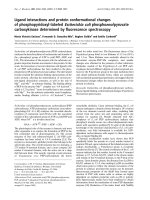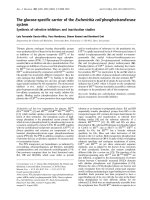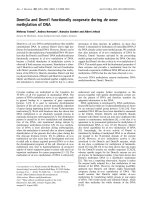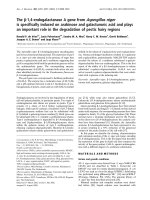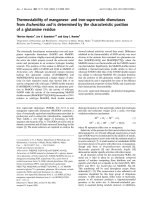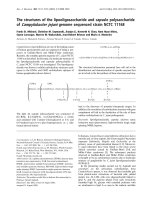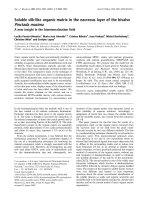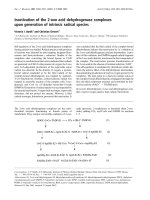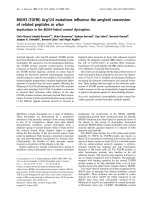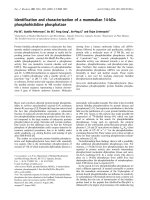Tài liệu Báo cáo Y học: Ornithine decarboxylase-antizyme is rapidly degraded through a mechanism that requires functional ubiquitin-dependent proteolytic activity pot
Bạn đang xem bản rút gọn của tài liệu. Xem và tải ngay bản đầy đủ của tài liệu tại đây (196.17 KB, 7 trang )
Ornithine decarboxylase-antizyme is rapidly degraded through
a mechanism that requires functional ubiquitin-dependent
proteolytic activity
Shilpa Gandre, Zippi Bercovich and Chaim Kahana
Department of Molecular Genetics, Weizmann Institute of Science, Israel
Antizyme is a polyamine-induced cellular protein that binds
to ornithine decarboxylase (ODC), and targets it to rapid
ubiquitin-independent degradation by the 26S proteasome.
However, the metabolic fate of antizyme is not clear. We
have tested the stability of antizyme in mammalian cells.
In contrast with previous studies demonstrating stability
in vitro in a r eticulocyte lysate-based degradation system, in
cells antizyme is rapidly degraded and this degradation is
inhibited by specific proteasome inhibitors. While the deg-
radation of ODC is stimulated by the presence of cotrans-
fected antizyme, degradation of antizyme seems to be
independent of ODC, suggesting t hat antizyme degradation
does not occur while presenting ODC to the 26S protea-
some. Interestingly, both species of antizyme, which repre-
sent initiation at two in-frame initiation c odons, are rapidly
degraded. The degradation of both antizyme proteins is
inhibited i n ts20 cells containing a thermosensitive ubiquitin-
activating enzyme, E1. Therefore we conclude that in
contrast with ubiquitin-independent degradation of ODC,
degradation of antizyme requires a functional ubiq uitin
system.
Keywords: antizyme; ornithine decarboxylase; protein deg-
radation; proteasome; polyamines.
The polyamines spermidine and spermine and t heir precur-
sor putrescine are ubiquitous aliphatic polycation s wi th
multiple cellular functions. Polyamines were demonstrated
to be essential for fundamental cellular processes such as
growth, differentiation, transformation and apoptosis [1–5],
although their explicit role in these cellular processes is
mostly unknown. Nevertheless, due to the critical role of
polyamines i n various cellular functions, multiple pathways
such as biosynthesis, catabo lism, uptake, and excretion
tightly r egulate their intracellular concentration. One of t he
major sources of ce llular polyamines c omes from t heir
synthesis from amino acid precursors. In this biosynthesis
pathway ornithine is decarboxylated to form putrescine by
the action of ornithine decarboxylase (ODC, EC 4.1.1.17).
Next an aminopropyl group generated by the action of
S-adenosylmethionine decarboxylase (EC 4.1.1.50) on
S-adenosylmethionine, is attached to putrescine and sper-
midine to form spermidine and spermine, respectively. Both
enzymes a re highly regulated and are subjected t o feedback
control by c ellular polyamines. Control of cellular polyam-
ines by rapid r egulated degradation of ODC constitutes an
important feedback regulatory mechanism.
ODC is one of the most rapidly degraded proteins in
eukaryotic ce lls. Interestingly it is degraded with out req ui-
ring ubiquitination [6,7]. Instead, ODC is targeted to
degradation due to its i nteraction with a u nique poly-
amine-induced protein termed antizyme [8]. Although not
requiring ubiquitination, the degradation of ODC also
occurs by the action of the 26S proteasome [8–10]. Synthesis
of antizyme requires translational frameshifting, which
results in bypassing a stop codon located shortly down-
stream of the initiation codon (ORF1) [11,12]. High
concentration of polyamines subverts the ribosome from
its original reading frame to the +1 frame to encode a
second ORF and synthesize complete functional antizyme
protein. A n tizyme binds to ODC s ubunit to f orm e n zymat-
ically inactive heterodimers [13]. The affinity of antizyme to
ODC subunits is higher than the affinity that ODC subunits
have to each other. Interaction between antizyme and ODC
subunits has two outcomes: ODC is inactivated [13], and the
ODC s ubunits are t argeted t o degradation [8,13–15]. It w as
suggested that binding of antizyme to ODC results in the
exposure of the C-terminal destabilizing signal of ODC [16].
Antizyme was a lso d emonstrated to negatively regulate the
process of polyamine transport by a yet unresolved
mechanism [17,18]. Mammalian cells contain another
relevant regulatory protein, antizyme inhibitor, a protein
that displays homology t o ODC, but lacks d ecarb oxylating
activity [19]. It binds to antizyme with higher affinity than
ODC thus it may release active ODC from the inactive
antizyme–ODC heterodimer [20].
While it is clear that interaction with antizyme is
absolutely required for marking ODC for rapid degrada-
tion, it is not clear what happens to antizyme during this
proteolytic process. Some studies performed in vitro in
degradation extracts s uggested that while targeting ODC to
degradation, antizyme remains stable and is released to
Correspondence to C. Kahana, Department of Molecular Genetics,
Weizmann Institute of Science, Rehovot, 76100, Israel.
Fax: + 972 8 9344199, Tel.: + 972 8 9342745,
E-mail:
Abbreviations: ODC: ornithine decarboxylase; DMEM, Dulbecco’s
modified Eagle’s medium.
Enzymes: ornithine decarboxylase (EC 4.1.1.17); S-adenosylmethio-
nine decarboxylase (EC 4.1.1.50).
(Received 23 October 2001, revised 20 December 2001, accepted
9 January 2002)
Eur. J. Biochem. 269, 1316–1322 (2002) Ó FEBS 2002
participate in subsequent cycles of ODC degradation
[2,13,21]. In contrast, other studies demonstrated rapid
degradation of antizyme in rat hepatoma (HTC) and HTC-
derived ODC overproducing cells under basal conditions
and after hypo-osmotic shock [22,23]. Additional studies
provided further support to the notion that antizyme is
rapidly degraded [24,25].
In the present study we have further investigated the
metabolic fate of antizyme in mammalian cells. We show
here that like ODC, antizyme is rapidly degraded by the
proteasome. However, in contrast with the degradation of
ODC that requires interaction with antizyme, the degrada-
tion of antizyme may occur without in teracting with ODC.
We also demonstrate that in c ontrast with the degradation
of ODC that occurs in a mutant cell line with a temperature-
sensitive ubiquitin-activating enzyme, E1, the degradation
of antizyme is imp aired at the restric tive temperature.
EXPERIMENTAL PROCEDURES
Materials
Proteasome inhibitors MG115 (Z-Leu-Leu-Norvalinal) and
MG132 (Z-Leu-Leu-Leucinal) were from C albiochem.
Tissue culture reagents and chemicals were from Sigma.
Constructs
Z1 rat antizyme DNA [26] was cloned into the pSVL vector
(Pharmacia) as a SalI(5¢)– ClaI(3¢) fragment. FLFS wild-
type rat antizyme DNA (containing the two initiation
codons) was cloned into t he pCI-neo e xpression vector
(Promega) as an EcoRI fragment or into the bicistronic
vector, pEFIRES-p [27], as a XhoI(5¢)-NotI(3¢)fragment.
FLFS DNA lacking the first initiation codon was cloned
into pCI-neo as a XbaI(5¢)–SalI(3¢) fragment. DNAs
encoding wild-type mouse ODC or the stable Del-6 mutant
[28] were cloned into pCI-neo as EcoRI(5¢)–XbaI(3¢)
fragments or into pEFIRES-p as XhoI(5¢)–NotI(3¢)
fragments.
Cells and cell culture conditions
The ODC overproducing mouse myeloma cell line, 653-1
was selected as described previously [29]. 653-1 and the
parental 653 cells were cultured at 37 °C in Dulbecco’s
modified Eagle’s medium (DMEM) containing 10%
bovine calf serum. a-Difluoromethylornithine (20 m
M
)
was added to the growth medium of 653-1 cells. The
human embryonic kidney epithelial 293 cells and monkey
cos-7 cells were cultured at 37 °C in DMEM containing
10% bovine c alf serum and transfected with the indicated
constructs, using the calcium phosphate precipitation
method [30]. To determine the degradation rate of the test
proteins, cycloheximide (20 lgÆmL
)1
) was added to t he
growth medium 48 h post-transfection and cellular extracts
were prepared at various times thereafter. The tested
proteins were then detected by Western blot analysis.
A31N-ts20 (containing thermosensitive ubiquitin-activating
enzyme, E1), and A31N (parental cells) [31] were cultured
at 32 °C in DMEM containing 10% foetal bovine serum.
They were transfected with the indicated constructs using
the X-tremeGENE Q2 Transfection reagent (Roche) as
recommended by the manufacturer. At the indicated times
the cells were transferred to the nonpermissive temperature
(39 °C) and cellular extracts were prepared 16 h thereafter.
The level of the indicated proteins was determined by
Western blot an alysis.
Western blot analysis
Cells were harvested at the indicated times, lysed in lysis
buffer (150 m
M
NaCl 50 m
M
Tris/HCl, pH 7.2, 0.5%
NP40, 1% Triton-X 100, 1% sodium deoxycholate) in the
presence of protease inhibitor cocktail. Protein concentra-
tion in the cellular extracts was determined u sing Bradford’s
method. Samples containing equal amounts of protein were
denatured in Laemmli buffer, fractionated by SDS/PAGE
and b lotted onto nitrocellulose membrane. The blots were
then probed with t he indicated antibodies, and the protein
signals were detected using the Supersignal chemilumines-
cence detection system (Pierce). These experiments were
repeated at least three times and representative data are
presented. The primary antibodies used were monoclonal
antimouse ODC (Sigma, clone ODC-29 originally devel-
oped by us), monoclonal antirat antizyme made by us which
recognizes amino acids 36–69 (with the second initiation
codon being amino acid number 1) and monoclonal
antimouse p53 (kindly provided by M. Oren).
Polyamine determination
Polyamines were determined essentially as described by
Seiler [32]. Ce lls were collected, resuspended i n 500 lL
NaCl/Pi and the material precipitating in 3% perchloric
acid was removed by centrifugation. Four-hundred
microlitres of dansyl c hloride (30 mgÆmL
)1
prepared in
acetone) was mixed with a 200 lL aliquot of the
supernatant; 20 mg of sodium carbonate was then added
and the mixture was incubated in the dark. After 12 h of
incubation 100 lL of proline (100 mgÆmL
)1
)wasadded
and the mixture was incubated for an additional 1 h.
Dansylated derivatives were then extrac ted into 0.5 mL
toluene. Portions (50–100 lL) were spotted on silica G-50
plates and the dansylated derivatives were resolved using
ethyl acetate/cyclohexane (2 : 3) as a solvent, with
dansylated derivatives of known polyamines serving as
markers. The individual polyamines were visualized by
UV illumination.
RESULTS
Antizyme is rapidly degraded by the action
of the 26S proteasome
While it is clear that interaction with antizyme is required
for the degradation of ODC, the cellular fate of antizyme
during this proteolytic process is unclear. The prominent
notion which is based predominantly on studies performed
in vitro in degradation extracts assumes that a ntizyme is a
stable protein that is recycled during the degradation of
ODC. We use here two cellular systems to determine
whether antizyme is a stable or a rapidly degraded protein.
We have noted that the ODC overproducing 653-1 mouse
myeloma cells [29,33–35] also show detectable levels of
antizyme (Fig. 1A, compare lanes 1 and 2) when grown
Ó FEBS 2002 Characterization of antizyme degradation (Eur. J. Biochem. 269) 1317
without the ODC inhibitor a-difluoromethylornithine. The
induction of antizyme expression can be attributed to the
accumulation of putrescine and cadaverine (Fig. 1B). As in
the case of O DC, the overexpressed a ntizyme was also
rapidly degraded and the specific proteasome inhibitor,
MG132 (Fig. 1A, lanes 2, 3 and 4) effectively inhibited this
degradation. The second system is based on monkey cos-7
cells that were transiently transfected with constructs
expressing rat a ntizyme. In order to uncouple between
antizyme expression and the requirement for polyamines,
we have utilized the Z1 antizyme clone to which an initiation
codon was appended in the +1 frame [26]. As a result,
frameshifting is not required for its expression [12,26]. In
both cases cycloheximide was added t o the growth medium
of the cells and cellular extracts were prepared at various
times thereafter. The extracts were resolved by SDS/PAGE
and a ntizyme was detected by Western b lot analysis using
specific antiantizyme monoclonal antibodies. As noted in
653-1 cells, also in transfected Cos-7 cells antizyme was
rapidly d egraded i n a proteasome-dependent manner
(Fig. 1 C). We therefore conclude that in contrast with the
observations made in the in vitro degradation systems, in
cells antizyme is a rapidly degraded protein and that as with
ODC, the degradation of antizyme is also carried out by the
proteasome.
Antizyme mRNA contains two variably used in-frame
initiation codons giving rise to two antizyme forms of 24
and 29.5 kDa [12,23]. Studies performed in vitro in a
reticulocyte lysate-based translation mix demonstrated that
the second initiation codon is utilized preferentially [11,12].
Utilization of the two initiation codons with clear preference
towards the second one was also inferred in HTC cells [24].
The above used Z1 antizyme represents initiation at the
second ATG thus enco ding the shorter form of antizyme.
To test for the cellular stability of the long form of antizyme
we used a full-length frame-shifted antizyme cDNA denoted
FLFS, which like the Z1 clone encodes antizyme without
requiring frameshifting [12]. As observed in the in vitro
translation system [12], also in transfected 293 cells initiation
of translation occurred predominantly at the second ATG
(Fig. 1 D). Both forms of antizyme were rapidly degraded
(Fig. 1 D).
Fig. 1. Antizyme is rapidly degraded in mammalian cells through the action of the proteasome. (A) 653-1 ODC overproducing cells were grown for
10 days without a-DFMO. Under these conditions ODC inhibition is relieved and a ntizyme is induced. Cycloheximide (CHX 20 lgÆmL
)1
)was
then added to the growth medium of 653-1 cells alone or together with the proteasome inhibitor, MG132 (50 l
M
). Cellular extracts were prepared at
the indicated times and aliquots containing 50 lg total protein were resolved by SDS/PAGES using a 12% polyacrylamide gel. The fractionated
material was transferred onto nitrocellulose membrane, which was then probed with anti-ODC and antiantizyme monoclonal antibodies. Signals
were detected using th e Supersignal Chemiluminescence detection system. Lane 1 contains equal amount of protein extracted from the p arental 653
cells. (B) Polyamines were extracted from 653 and 653-1 cells and analysed as described in Experimental procedures. (C) Cos-7 cells were transfected
with the pSVL-Z1 co nstruct. Forty-eight hours post-transfection cycloheximide was added to the growth medium alone o r together with the
proteasome inhibitor, MG115. Cellular extracts were prepared and analysed as described in A. (D) 293 cells were transfected with expression
constructs containing wild-type antizyme (FLFS, see Experimental procedures) DNA. Cellular extracts were prepared and analysed as
described in A. The molecular weight and position of the two forms of antizyme is indicated on the right. *NS indicates the position of nonspecific
proteins recognized by the antibodies.
1318 S. Gandre et al. (Eur. J. Biochem. 269) Ó FEBS 2002
The degradation of antizyme is independent
of the degradation of ODC
As demonstrated above, antizyme, the mediator of ODC
degradation is itself rapidly degraded. Therefore, we set out
to determine whether this degradation occurs together with
ODC while presenting ODC to the proteasome or whether
the degradation of antizyme is independent of that of ODC.
293 cells were transfected with constructs encoding ODC,
antizyme or both. As demonstrated before [8,13,36], coex-
pression with antizyme stimulated the degradation of ODC
(Fig. 2D). In contrast, antizyme was rapidly degraded in
both the presence and the absence of coexpressed ODC
(Figs 2C and D). Similarly, we have noted that antizyme
that was induced by the addition of spermidine to the
growth medium was degraded with similar kinetics (half-life
% 1 h) in 653-1 cells that massively overproduce O DC and
in their pare ntal 653 cells in which ODC is prac tically
undetected (Fig. 2 A and B). Moreover, in 653-1 cells the
degradation rate of antizyme was different from that of
ODC. Although our results do not necessarily negate the
notion that antizyme may be degraded together with ODC,
they suggest that interaction with ODC is not essential f or
the degradation of antizyme. This conclusion is supported
mainly by the experiment like that presented in Fig. 2A as in
653 cells antizyme is present in vast excess whereas ODC is
practically undetected. Testing for antizyme degradation in
cells completely lacking ODC protein will allow d rawing of
a definite conclusion. Interestingly, coexpression of anti-
zyme together with the stable ODC variant, Del6, which
lacks the C-terminal degradation signal [28], stabilized
antizyme (Fig. 3). Similar stabilization of antizyme was
observed when it was coexpressed with a stable ODC
variant in which Cys441 was converted to Trp [22].
The degradation of antizyme depends on the p resence of
an active ubiquitin-dependent proteolytic system. The
observation that antizyme is capable of being d egraded
independently of ODC prompted us to characterize this
degradation process. As degradation through the ubiquitin
system is a prominent possibility we have investigated
antizyme degradation in ts20 cells, containing a thermosen-
sitive ubiquitin-activating enzyme E1 [31]. It was demon-
strated that in these cells, p53, a typical substrate of the
ubiquitin system, accumulates upon their shift to the
nonpermissive temperature [31]. E xpression constructs
encoding ODC and antizyme were transfected into ts20
cells and into their parental wild-type c ells and the cells were
kept at the permissive temperature (32 °C). Twenty-four
hours post-transfection half of the cells were transferred to
the restrictive temperature (39 °C) and incubated for
additional 16 h. Cellular extracts were then prepared and
the relevan t prote ins were detected by Western blot analysis.
Fig. 2. Antizyme degradation can occur independently of the degradation of ODC. (A) 653 and 653-1 c ells were treated with 5 m
M
spermidine in the
presence of 1 m
M
aminoguanidine (an inhibitor of serum amine oxidases) for 1 h in order to induce antizyme. Cycloheximide (20 lgÆmL
)1
)was
added to the growth medium and cellular extracts were prepared and analysed as described in Fig. 1. The lanes r epresenting 653 cells contain twice
the amount of protein as those representing 653-1 cells. (B) The blot presen ted in A was scanned u sing a UmaxIII scanner and
PHOTOSHOP
-4.0. The
relative intensities of the antizyme bands were determined by using
IMAGE GAUGE
V3.41 (C and D). Cos-7 cells were transfected with expression
constructs encoding antizyme (the short form) o r ODC (C), or were cotransfected with both exp ression constructs (D). Forty-eight hours post-
transfection th e cells were treated with cycloheximide and MG132 for the indicated times. Cellular extracts were prepared, fractionated and
antizyme and ODC detected as described in Fig. 1.
Ó FEBS 2002 Characterization of antizyme degradation (Eur. J. Biochem. 269) 1319
The two control proteins, p53 and ODC, behaved as
expected: en dogenous p53 accumulated only in the ts20 cells
grown at the restrictive temperature but not in wild-type
cells (Fig. 4). In contrast, not only did ODC not accumulate
in either cell line but its concentration was actually slightly
reduced at the restrictive t emperature (Fig. 4), probably due
to accelerated degradation at 39 °C. As shown in the figure,
both forms of antizyme accumulated in ts20 cells at the
nonpermissive temperature. We therefore conclude that
antizyme, the mediator of the ubiquitin-independent degra-
dation of ODC, requires a functional ubiquitin system for
its degradation.
DISCUSSION
Antizyme is a unique cellular regulatory protein that is both
regulated by polyamines and regulates polyamine metabo-
lism in a feedback loop. Antizyme expression is regulated
translationally by a polyamine-stimulated ribosomal frame-
shifting [2,11,12]. In turn, antizyme contributes to reducing
the intracellular concentration of polyamines, both by
marking ODC for rapid degradation [2,8,13,37], and by
reducing polyamine uptake via a yet unknown mechanism
[17,38–40]. In this sense antizyme expression by frameshift-
ing serves a s the cellular sensor for polyamines. While the
molecular mechanisms by which antizyme directs ODC to
degradation is partially revealed (reviewed in [2,37]), there is
ambiguity about the fate of antizyme during this proteolytic
process. Previous studies performed in vitro in degradation
extracts suggested that while taking ODC to the protea-
some, antizyme remains stable and is recycled to participate
in subsequent rounds of ODC degradation [2,13,21]. In
contrast, other studies suggested that antizyme is also a
rapidly degraded protein [8,23–25].
We demonstrate here that endogenous antizyme in the
ODC overproducing 653-1 cells and antizyme that is
expressed in 293 cells from an expression vector is rapidly
degraded. Like the degradation of ODC, the degradation of
antizyme is also mediated by the proteasome as specific
inhibitors of this protease effectively inhibit this proteolytic
process. This result refutes the long-standing idea that
antizyme is a stable protein [2,13,21]. The rapid degradation
of antizyme is compatible with the critical role this protein
plays in regulating cellular polyamine levels. A key protein
such as antizyme can not function as an effective r egulator
unless it is rapidly degraded or its activity is tightly
modulated.
Rapid degradation of antizyme may suggest that it is
degraded together with ODC while taking the latter to the
26S proteasome. In such a case it could be expected that
stoichiometric relationship would be required for the
degradation of these two proteins. Indeed, as demonstrated
previously [36], cotransfection with antizyme accelerated
ODC degradation. In contrast, the degradation of antizyme
was not affected by the simultaneous expression of ODC.
Similarly, the rate of antizyme degradation in 653-1 cells
which contain large amount of ODC is identical to that
observed in 653 cells in which ODC is practically undetec-
ted. These results strongly support the alternative possibility
that the degradation of antizyme is independent from that
of ODC. Further in supporting this possibility is the
observation that ODC a nd antizyme differ in their rate of
degradation in 653-1 cells (Fig. 2B). Therefore, w e can
conclude that even if antizyme is degraded together with
ODC, its degradation can also occur independently of
ODC. As demonstrated here (Fig. 3) antizyme degradation
was inhibited when it was expressed together with the stable
ODC variant. A similar observation was made recently and
in a previous study [22]. The interpretation in that study was
Fig. 4. Degradation of antizyme depends on the integrity of the ubiqui-
tination machinery. Wild-type (A31N) and ts20 cells containing ther-
mosensitive ubiquitin-activating enzyme E1 were transfected with
expression constructs encoding ODC and antizyme (FLFS antizyme).
The transfected cells were incubated for 24 h at 32 °C (permissive
temperature) and then half of the cells were transferred to 39 °C
(restrictive temperature) for an additional 16 h. Cellular extracts were
prepared, fractionated and the proteins of i nterest were detected by
immunoblotting.
Fig. 3. Co-expression with the stable ODC mutant, Del-6, inhibits
antizyme degradation. 293 cells were cotransfected with expression
constructs encoding antizyme and the stable ODC mutant, Del6 that
lacks the C-terminal destabilizing segment encompassing amino acids
423–461. The transfected cells were treated and antizyme and ODC
were detected as described in Fig. 1.
1320 S. Gandre et al. (Eur. J. Biochem. 269) Ó FEBS 2002
that as part of a complex that is a poor substrate for the 26S
proteasome, antizyme is protected from degradation [22].
We propose here an a lternative possibility, that antizyme is
protected from degradation not because it is trapped in a
poorly degradable complex but because it should be free in
order to be recognized and marked for rapid degradation. It
will be of great interest in this respect to determine how
interaction with antizyme inhibitor [19,20,41–43] affects
antizyme degradation.
The observation that antizyme may be degraded inde-
pendently of ODC raised the possibility t hat antizyme may
be degraded via different recognition machinery. The major
cellular proteolytic system responsible for marking the
destiny of a protein to rapid degradation is the u biquitin-
dependent proteolytic system [44–47]. We have used the
Balb/C 3T3-derived cell line ts20 that contains a thermo-
sensitive ubiquitin-activating enzyme E1 [31] to determine
whether the ubiquitin system is involved in t he degradation
of antizyme. Two control proteins were used in this
experiment: p53 a substrate of the ubiquitin system that
was demonstrated to accumulate in t he mutant cells at the
nonpermissive temperature; and ODC whose degradation is
independent of ubiquitination. As expected p53 accumu-
lated at the restrictive temperature while ODC did not. In
fact, p robably due to increased degradation activity at the
restrictive temperature (39 °C) the level of ODC actually
dropped. Both forms of antizyme, which represent initia-
tions at two altern ative translation start sites, accumulated
in the mutant cells at the nonpermissive temperature. We
therefore conclude that a f unctional ubiquitin system is
required for the degradation of antizyme. This is an
interesting situation in which antizyme, the protein that
marks ODC to rapid ubiquitin-independent degradation
may be itself degraded through the ubiquitin system. It must
be emphasized however, that while our results demonstrate
that a functional ubiquitin system is required for the
degradation of antizyme, we cannot state that antizyme is
directly targeted for the degradation by ubiquitination as we
could not demonstrate the presence of ubiquinated anti-
zyme (in cells cotransfected with antizyme and HA-ubiqui-
tin). Such demonstration may require the identification of
the components of the ubiquitin sytem (E2 and E3) involved
in mediating antizyme d egradation as such components a re
likely to be limiting. Indeed, ubiquinated forms of p53 were
noted only when p53 and HA-ubiquitin were complemented
by MDM2 (E3 for p53) in the t ransfection assay. The
revelation of their potential relationships to the cellular
polyamine metabolism will be of great interest.
ACKNOWLEDGEMENTS
We thank S. Hobbs for the pEFIRES-p vector and H. L. Ozer for the
A31N wild type and ts20 cells. This stud y was supported by a grant from
the Leo and Julia Forchheimer Center for Molecular Genetics at the
Weizmann In stitute of Science and by a research grant fro m the Israeli
science foundation and the Jean-Jacques Brunschwig memorial fund.
REFERENCES
1. Coffino, P. & Poznanski, A. (1991) Killer polyamines? J. Cell
Biochem. 45, 54–58.
2. Coffino, P. (2001) Regulation of cellular polyamines by antizyme.
Nature Rev. Mol. Cell Biol. 2, 188–194.
3. Marton, L.J. & Pegg, A.E. (1995) Polyamines as targets for
therapeutic intervention. An nu. Rev. Pharmacol. Toxicol. 35,
55–91.
4. Tabor, C.W. & Tabor, H. (1984) Polyamines. Annu. Rev. Biochem.
53, 749–790.
5. Tabor, C.W. & Tabor, H. (1985) Polyamines in microorganisms.
Microbiol. Rev. 49, 81–99.
6. Bercovich, Z., Rosenberg-Hasson, Y., Ciechanover, A. &
Kahana, C. (1989) Degradation of ornithine decarboxylase in
reticulocyte lysate is ATP-dependent bu t ubiquitin-independent.
J. Biol. Chem. 264, 15949–15952.
7. Rosenberg-Hasson, Y., Bercovich, Z., Ciechanover, A. &
Kahana, C. (1989) Degradation of ornithine decarboxylase in
mammalian cells is ATP dependent but ubiquitin independ ent.
Eur. J. Biochem. 185, 469–474.
8. Murakami, Y., Matsufuji, S., Kameji, T., Hayashi, S., Igarashi,
K., Tamura, T., Tanaka, K. & Ichihara, A. (1992) Ornithine
decarboxylase is degraded by the 26S proteasome without
ubiquitination. Nature 360, 597–599.
9. Mamroud-Kidron, E. & Kahana, C. (1994) The 26S proteasome
degrades mouse and yeast ornithine decarboxylase in yeast cells.
FEBS Lett. 356, 162–164.
10. Mamroud-Kidron, E., Rosenberg-Hasson, Y., Rom, E. &
Kahana, C. (1994) The 20S proteasome mediates the degradation
of mouse and yeast o rnithine decarboxylase in yeast cells. FEBS
Lett. 337, 239–242.
11. Matsufuji, S., Matsufuji, T., Miyazaki, Y., Murakami, Y., Atkins,
J.F., Gesteland, R.F. & Hayashi, S. (1995) Autoregulatory frame-
shifting in decoding mammalian ornithine decarboxylase anti-
zyme. Cell 80, 51–60.
12. Rom, E. & Kahana, C. (1994) Polyamines regulate the expression
of ornithine decarboxylase antizyme in vitro by inducing ribo-
somal frame-shifting. Proc.NatlAcad.Sci.USA91, 3959–3963.
13. Mamroud-Kidron, E., Omer-Itsicovich, M., Bercovich, Z.,
Tobias, K.E., Rom, E. & Kahana, C. (1994) A unified pathway for
the degradation of ornithin e decarboxylase in reticulocyte lysate
requires interaction with the polyamine-induced protein, ornithine
decarboxylase antizyme. Eur. J. Biochem. 226, 547–554.
14. Li, X. & Coffino, P. (1992) Regulated degradation of ornithine
decarboxylase requires interaction with the polyamine-inducible
protein antizyme. Mol. Cell Biol. 12, 3556–3562.
15. Murakami, Y., Tanaka, K., Matsufuji, S., Miyazaki, Y. &
Hayashi, S. (1992) Antizyme, a protein induced by polyamines,
accelerates the degradation of ornithine decarboxylase in Chinese-
hamster ovary-cell extracts. Biochem. J. 283, 661–664.
16. Li, X. & Coffino, P. (1993) Degradation of ornithine decar-
boxylase: exposure of the C-terminal target by a polyamine-
inducible inhibitory protein. Mol. Cell Biol. 13, 2377–2383.
17. Mitchell, J.L., Judd, G.G., Bareyal-Leyser, A. & Ling, S.Y. (1994)
Feedback repression of polyamine transport is mediated by anti-
zyme in mammalian tissue-culture cells. Biochem. J. 299, 19–22.
18. Suzuki,T.,He,Y.,Kashiwagi,K.,Murakami,Y.,Hayashi,S.&
Igarashi, K. (1994) Antizyme protects against abnormal accu-
mulation and toxicity of polyamines in ornithine decarboxylase-
overproducing cells. Proc. Natl Acad. Sci. USA 91, 8930–8934.
19. Murakami, Y., Ichiba, T., Matsufuji, S. & Hayashi, S. (1996)
Cloning of antizyme inhibitor, a highly homolog ous protein to
ornithine decarboxylase, J. Biol. Chem. 271, 3340–3342.
20. Nilsson, J., Grahn, B. & Heby, O. (2000) Antizyme inhibitor is
rapidly induced in growth -stimulated m ouse fib roblasts and
releases ornithine decarboxylase from antizyme suppression.
Biochem. J. 346, 699–704.
21. Tokunaga, F., Goto, T., Koide, T., Murakami, Y., Hayashi, S.,
Tamura, T., Tanaka, K. & Ichihara, A. (1994) ATP- and anti-
zyme-dependent endoproteolysis of ornithine decarboxylase to
oligopeptides by the 26S proteasome. J. Biol. Chem. 269, 17382–
17385.
Ó FEBS 2002 Characterization of antizyme degradation (Eur. J. Biochem. 269) 1321
22. Mitchell, J.L., Choe, C.Y., Judd, G.G., Daghfal, D.J., Kurzeja,
R.J. & Leyser, A. (1996) Overproduction of stable ornithine
decarboxylase and antizyme in the difluoromethylornithine-
resistant cell line DH23b. Biochem. J. 317, 811–816.
23. Mitchell, J.L., Judd, G.G., Leyser, A. & Choe, C. (1998) Osmotic
stress induces v ariation in cellular levels of ornithine decar-
boxylase-an tizyme. Biochem. J. 329, 453–459.
24. Hayashi, S. & Murakami, Y. (1995) Rapid and regulated
degradation of ornithine decarboxylase. Biochem. J. 306, 1–10.
25. Murakami, Y., Fujita, K., Kameji, T. & Hayashi, S. (1985)
Accumulation of ornithine decarboxylase-antizyme complex in
HMOA cells. Biochem. J. 225, 689–697.
26. Matsufuji, S., Miyazaki, Y., Kanamoto, R., Kameji, T.,
Murakami, Y., Baby, T.G., Fujita, K., Oh no, T. & Hayashi, S.
(1990) Analyses of ornithine decarboxylase antizyme mRNA with
a cDNA cloned from rat liver. J. Biochem. (Tokyo) 108, 365–371.
27. Hobbs, S., Jitrapakdee, S. & Wallace, J.C. (1998) Development of
a bicistronic vector driven by the human polypeptide chain elon -
gation factor 1alph a promoter for creation of stable mammalian
cell lines that express very high levels o f recom binant proteins.
Biochem. Biophys. Res. Commun. 252, 368–372.
28. Rosenberg-Hasson, Y., Bercovich, Z . & Kahana, C. ( 1991)
Characterization of sequences involved in mediating degradation
of ornithine decarboxylase in cells and in reticulocyte lysate. Eur.
J. Biochem. 196, 647–651.
29. Kahana, C. & Nathans, D. (1984) Isolation of cloned cDNA
encoding mammalian ornithine decarboxylase. Proc. Natl Acad.
Sci. USA 81, 3645–3649.
30. Graham, F.L. & van der Eb, A.J. (1973) A new technique for the
assay of infectivity of human adenovirus 5 DNA. Virology 52,
456–467.
31. Chowdary, D .R., Dermody, J.J., Jha, K.K. & Ozer, H.L. (1994)
Accumulation of p53 in a mutant cell line defective in the ubiquitin
pathway. Mol. Cell Biol. 14, 1997–2003.
32. Tobias, K.E. & Kahana, C. (1995) Exposure to o rnithine results in
excessive accumulation of putrescine and apoptotic cell death in
ornithine decarboxylase overproducing mouse myeloma cells. Cell
Growth Differ. 6, 1279–1285.
33. Kahana, C. & Nathans, D. (1985) Translational regulation of
mammalian ornithine decarboxylase by polyamines. J. Biol.
Chem. 260, 15390–15393.
34. Kahana, C. & Nathans, D. (1985) Nucleotide sequence of murine
ornithine decarboxylase mRNA. Proc. Natl Acad. Sci. USA 82,
1673–1677.
35. Katz, A. & Kahana, C. (1989) Rearrangement between ornithine
decarboxylase and the s witch region of the gamma 1
immunoglobulin gene in alpha-diflu oromethylornith ine resistant
mouse myeloma cells. EMBO J. 8, 1163–1167.
36. Murakami, Y., Matsufuji, S., Miyazaki, Y. & Hayashi, S. (1992)
Destabilization of ornithine decarboxylase by transfected anti-
zyme gene expression in hepatoma tissue culture cells An tizyme2 is
a negative regulator of ornithine decarboxylase and polyamine
transport. J. Biol. Chem. 267, 13138–13141.
37. Coffino, P. (2001) Antizyme, a mediator of ubiquitin-independent
proteasomal degradation. Biochimie 83, 319–323.
38. Sakata, K., Kashiwagi, K. & Igarashi, K. (2000) Properties of a
polyamine transporter regulated by antizyme. Biochem. J. 347,
297–303.
39. Zhu, C., Lang, D .W. & Coffino, P. (1999) Antizyme2 is a negative
regulator of ornithine decarboxylase and polyamine transport.
J. Biol. Chem. 274, 26425–26430.
40. Sakata, K., Fuku chi-Shimogori, T., Kashiwagi, K. & Igarashi, K .
(1997) Identification of regulatory region of antizyme necessary
for the negative regulation of polyamine transport. Biochem.
Biophys. Res. Commun. 238, 415–419.
41. Koguchi, K., Kobayashi, S., Hayashi, T., Matsufuji, S.,
Murakami, Y. & Hayashi, S. (1997) Cloning and sequencing of a
human cDNA encoding ornithine decarboxylase antizyme
inhibitor . Biochim. Biophys. Acta 1353, 209–216.
42. Kitani, T. & Fujisawa, H. (1989) Purification and characterization
of antizym e inhibitor of ornithine decarboxylase from rat liver.
Biochim. Biophys. Acta 991, 44–49.
43. Fujita, K., Murakami, Y. & Hayashi, S. (1982) A macromolecular
inhibitor of the antizyme to ornithine decarboxylase. Biochem.
J. 204, 647–652.
44. Ciechanover, A., Orian, A. & Schwartz, A.L. (2000) Ubiquitin-
mediated proteolysis: biological regulation via destruction.
Bioessays 22, 442–451.
45. Ciechanover, A., Orian, A. & Schwartz, A.L. (2000) The ubiqui-
tin-mediated proteolytic pathway: mode of action and clinical
implications. J. Cell Biochem. 34 (Suppl.), 40–51.
46. Hershko, A. & Ciechanover, A. (1992) The ubiquitin system for
protein degradation. Annu. Rev. Biochem. 61, 761–807.
47. Kornitzer, D. & Ciechanover, A. (2000) Modes of regulation
of ubiquitin-mediated protein degradation. J. Cell Physiol. 182,
1–11.
1322 S. Gandre et al. (Eur. J. Biochem. 269) Ó FEBS 2002
